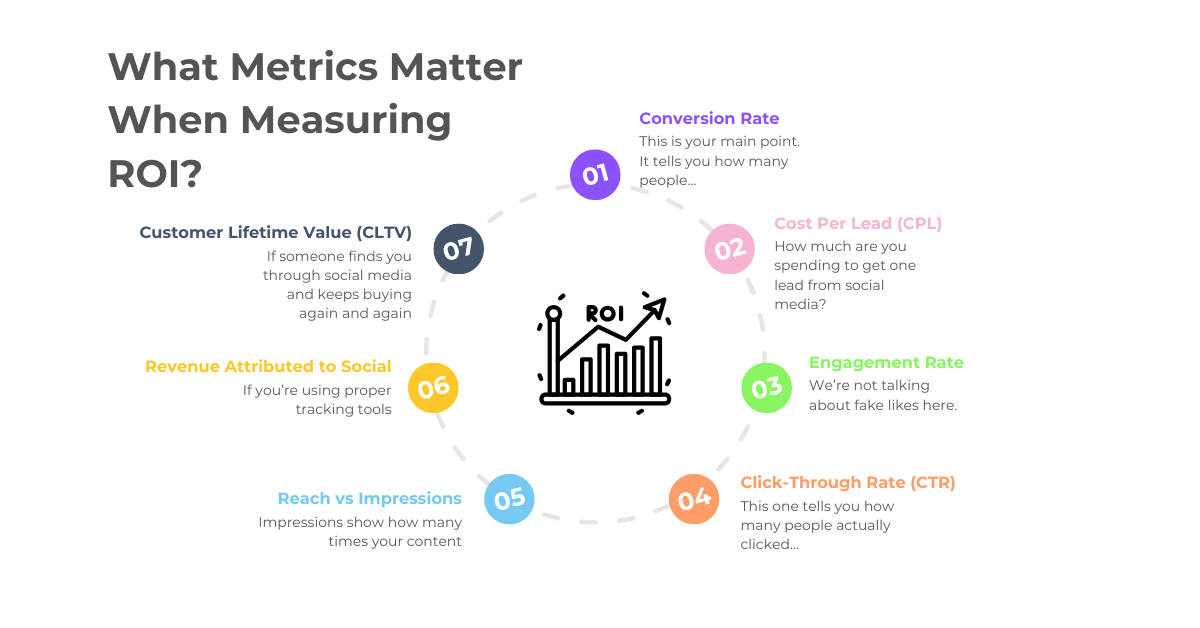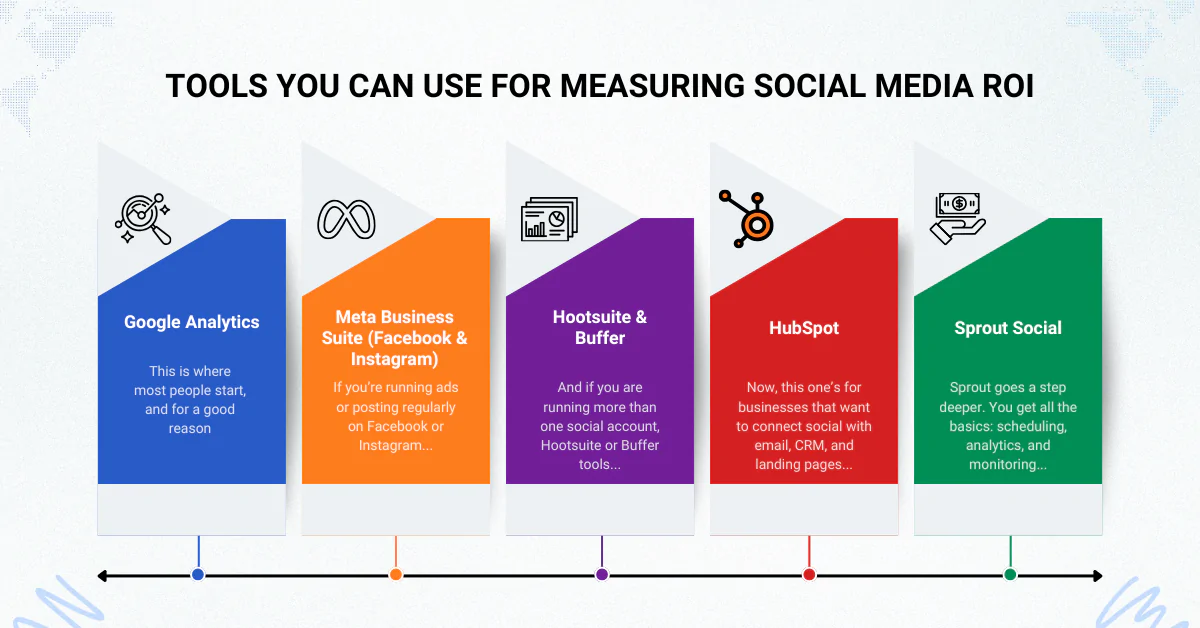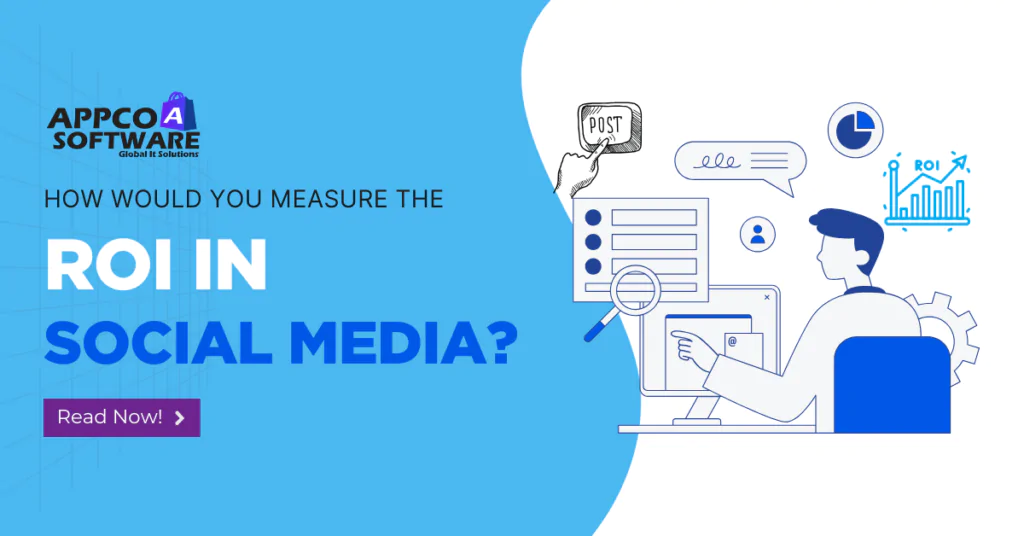These days, almost every brand—big or small—is on social media. From daily Instagram posts to long-form videos on YouTube, brands are showing up everywhere. But here’s the real question: is it working? And more importantly, how do you even know if it’s working?
Over 91% of businesses now use social media as part of their marketing, yet only 15% say they’re confident in how they track the returns. And in our opinion, that’s a pretty wide gap.
And of course, posting regularly, getting likes, or going viral sounds nice, but if you’re not tracking results properly, it’s just noise. Well, this post breaks down exactly how you can figure out the return on what you’re putting into your social media. Nothing too technical, just straight-up, easy-to-follow stuff.
What is ROI in Social Media?
ROI in social media, put simply, is figuring out whether all that effort you’re putting into social media is actually worth it. You post, you run ads, you boost reels, you answer DMs. But is any of that turning into sales, leads, or growth? That’s what ROI (Return on Investment) helps you measure your efforts.
Most people might think that on social media, you just have to get thousands of likes, comments, or followers. But none of that really means much unless it brings real results. And by results, we’re talking about numbers that actually matter for your business — revenue, sign-ups, inquiries, or conversions.
Let’s say you spent ₹50,000 last month running a campaign on Instagram through a social media advertising company. If that campaign helped you generate ₹2,00,000 in actual business, your ROI is positive, in this case. But if it only brought in a bunch of likes and no leads, you probably wasted money.
Tracking ROI on social media is kind of challenging because not everything is direct. Someone might see your ad today, visit your page tomorrow, and buy something next week. So, you’ll need a mix of tracking tools and common sense to connect the dots.
If you’re serious about getting better at this, your social media marketing strategy should include clear goals — like more sales, sign-ups, or clicks — not just “post daily and hope for the best.” You can also use tools like UTM links, analytics, and pixel tracking to see where your traffic and conversions are really coming from.
Also read – Social Media Optimization Services: A Comprehensive Overview
Why Is Measuring Social Media ROI Important?
Social media eats up time, money, and energy. And still, to become successful, you need to focus on this part. From designing creatives to running paid campaigns to replying to DMs, it takes work. A lot of hard work. And if you’re not measuring what you’re getting back in return, you’re flying blind. Tracking ROI in social media is important for one big reason: it tells you what’s working and what’s just draining your budget.
If you’re running five different social media marketing campaigns — Instagram ads, Facebook reels, influencer shoutouts, LinkedIn posts, and some Pinterest pins — wouldn’t you want to know which one actually brought customers? That’s the whole point. You’re not doing this for fun. You want results.
Let’s say your team is creating content every single day, but your audience is not growing, or you are not getting any leads. Without measuring ROI, you’ll just keep posting and hoping. But when you start tracking results properly, it becomes easier to focus on what actually works.
This is also where tools come in work. If you’re using proper social media marketing tools — like Meta Pixel, Google Analytics, UTM tags, and heatmaps — you’ll know which post, ad, or campaign brought the highest conversions. And that’s real power. That’s how you build a strong, numbers-backed social media marketing strategy.
It’s not just about tracking sales either. You can measure other valuable things, like how many people messaged you, signed up for your newsletter, downloaded your app, or shared your product with friends. And if you’re working with a social media optimization service company, they should be showing you clear monthly reports, not the charts.
What Metrics Matter When Measuring ROI?

If you’re serious about tracking ROI in social media, then you need to stop just counting likes and start focusing on numbers that actually show value. A post with 1,000 hearts is great, but if it doesn’t bring any leads, sales, or sign-ups — what’s the point?
Here are the real metrics that matter when it comes to measuring social media marketing return on investment:
1. Conversion Rate
This is your main point. It tells you how many people saw your post or ad and took action — bought something, signed up, booked a call, whatever your goal is. If you’re running a proper social media marketing campaign, this is one of the top things to watch.
2. Cost Per Lead (CPL)
How much are you spending to get one lead from social media? Whether you’re running a giveaway or a paid ad, this metric tells you if your spend is worth it.
3. Engagement Rate
We’re not talking about fake likes here. Look at meaningful engagement — comments, shares, saves, & DMs. It shows how well your content connects with real people. If your engagement is high, your strategy is working.
4. Click-Through Rate (CTR)
This one tells you how many people actually clicked on your link after seeing your ad or post. Low CTR means your content may look nice, but it’s not convincing people to take action.
5. Reach vs Impressions
Impressions show how many times your content was shown. Reach shows how many actual people saw it. The gap between the two gives you an idea of repetition and saturation, both matters when planning future posts.
6. Revenue Attributed to Social
If you’re using proper tracking tools — like UTM tags or analytics dashboards — you can actually see how much money your social content brings in. And this, in the end, is the clearest way to track ROI in social media.
7. Customer Lifetime Value (CLTV)
If someone finds you through social media and keeps buying again and again, that’s your long-term win. Knowing this helps you decide how much you can spend to acquire a customer from social media.
Also Read – How to Boost Your Shopify Store with Social Media Optimization
How to Set Up Goals for ROI Tracking
![]()
Before you even start posting on social media or running ads, you need to ask yourself a pretty basic question: What are you trying to achieve here? If your goal is not clear, then measuring ROI in social media is just an idea. And that’s where most businesses go wrong.
Start with choosing the right type of goal first of all. Here’s how you can break it down:
1. Awareness Goals:
If you’re just starting out for the very first time, your goal might be to get your brand in front of more people. That means you’ll be focusing on reach, impressions, and engagement rates. But remember, these are early-stage goals, and you should not think about making sales here.
2. Lead Generation Goals:
This is where things get a little more serious. You want email signups, downloads, DMs, form fills — something that shows people are interested. To track this, connect your social channels with your CRM or lead tracking tool.
3. Sales Goals:
Now we’re talking about real ROI. If your main goal is to make sales or signups, set a goal that directly relates to revenue. You can track this with tools like Meta Pixel, Google Analytics, or custom UTM tags on your posts.
4. Retention or Loyalty Goals:
Sometimes, the goal is not just to sell your service or product once. You want customers to return and buy that thing again and again. In that case, measure things like returning customers from social campaigns, repeat purchases, and engagement with your existing followers.
Tools You Can Use for Measuring Social Media ROI

If you want to see what’s working (and what’s not), you’ll need a few tools to measure the numbers behind your social media marketing. And no, checking likes manually doesn’t matter.
Here are some tools that make tracking ROI on social media less stressful:
1. Google Analytics
This is where most people start, and for a good reason. Google Analytics helps you see who came from where and what they did after they landed. You’ll know if someone clicked on your Instagram link, viewed a product, or dropped off at checkout. The trick is to use UTM links. Without those, it’s just a waste of time. Set them up properly, and you’ll see clear trails from your social media marketing campaigns straight to conversions. No more uncertainty about if your content is working or not.
2. Meta Business Suite (Facebook & Instagram)
If you’re running ads or posting regularly on Facebook or Instagram, this tool is a must. It’s free and shows everything from likes, shares, link clicks, to actual purchases—if your Pixel is set up right. You can create custom reports, compare organic vs. paid posts, and see what people do after they see your post. For tracking ROI on social media, especially when you’re boosting posts or running retargeting ads, this tool gives you the full picture without knowing what you’re doing.
3. Hootsuite & Buffer
And if you are running more than one social account, Hootsuite or Buffer tools can help you a lot, and in many ways. You can schedule content, track which posts get the most clicks, and respond to comments, all in one place. These tools are not just for posting but help you see what type of content actually brings traffic or conversions. You’ll also find engagement reports, the best time to post, and campaign breakdowns. This is super helpful when you’re building out a full social media marketing strategy and want to back it up with data.
4. HubSpot
Now, this one’s for businesses that want to connect social with email, CRM, and landing pages. HubSpot tracks the full path—from someone liking a post to becoming a paying customer. You can see what campaign brought them in, what they clicked on, and what they did after that. If you’re doing lead generation or B2B marketing, HubSpot gives you everything you need to show social media marketing return on investment in real numbers, not just reactions and comments.
5. Sprout Social
Sprout goes a step deeper. You get all the basics: scheduling, analytics, and monitoring. But it also shows real impact. You can track revenue from posts, identify what drives actual sales, and even track customer service interactions via DMs. It’s really useful if your team wants to see how social efforts change over time. For agencies or large teams, it helps build clear, easy-to-read reports that show clients the hard truth, what’s working, and what’s just eating up the budget.
Also Read – How Can I Convert Social Media Followers into Website Traffic?
When Should You Hire a Social Media Agency?
You can run your own social media, post a few things, maybe boost a reel here and there. But sooner or later, you’ll need to work with an agency. After some time, your posts might stop performing. The leads slow down. The content starts feeling like noise. You know when it’s time to bring in the pros when that happens.
You should think about hiring a social media advertising company when:
- You’re spending money on ads but can’t figure out if they’re working.
- Your followers are growing, but you’re not getting the engagements and sales.
- Your in-house team is overwhelmed and just posting to keep the calendar full.
- You want to scale, but you’re guessing your way through the process.
- You need someone to take care of your social media marketing strategy, content, performance, and reporting.
A good agency, for example, will not just post graphics with some motivational quotes. But the right team will look deeper into your business, build a plan, track ROI in social media, and change things that have not been working for some time. The agency uses tools, data, and experience to make better decisions, not just pretty posts.
And if your team needs help figuring out what content sells, how to read analytics, or how to tie posts back to actual revenue, that’s where you should call your friend and ask if he knows a good social media advertising company.
How Appco Software Can Help You with Social Media ROI
At Appco Software, if you decide to work with us, our social media experts don’t believe in just getting you likes and followers. We care about what happens after someone clicks. If you’re trying to figure out how to get real results from your social media marketing—leads, sales, calls, conversions—we’ll help you track and improve every bit of it.
We work closely with brands that want to get some real results. And most importantly, we put a lot of time and effort into building a social media marketing strategy that will drive results through content, targeting, and numbers you can see week in, week out.
No matter if you’re running ads on Instagram, posting reels on Facebook, or trying to grow your business with a fresh campaign, our team uses the right social media marketing tools and data to show you exactly what’s working and what’s not.
Here are some other services we can provide:
- Shopify Speed Optimization
- Shopify Store Rebuild
- Shopify Theme Customization
- Shopify Store Development
- Shopify Custom App Development
- Shopify Conversion Rate Optimization
- E-commerce to Shopify Migration
- Website Maintenance Services
- Digital Marketing Services
- Performance Marketing Services
- SEO Services
- Social Media Optimization Service
The Final Say
There it is. ROI in social media is not when you only chase likes or boost posts and hope for the best. It’s about knowing exactly what your business gets back from every rupee you spend online. The truth is, most businesses run campaigns without really knowing what’s working and what’s just noise. But once you set the right goals, track the right numbers, and actually use tools that make sense for your brand —things get clearer. And if you’ve been struggling with all the metrics, platforms, or figuring out where to even begin, that’s where a digital marketing team like Appco Software can help you.
ROI in Social Media FAQs
1. What is ROI in social media marketing?
It’s how much return (money, leads, etc.) you get for what you spend on social platforms.
2. How do I track social media ROI?
Use tools like Google Analytics, UTM links, and ad dashboards to see what’s converting.
3. What’s the best ROI for social media?
It does depend on your industry, but a positive ROI is when you earn more than you spend on an advertisement.
4. Can likes and comments be considered ROI?
Yes, only if the likes and comments lead to clicks, conversions, or real brand value.
5. What’s the best tool for measuring ROI?
Google Analytics, Meta Ads Manager, and tools like Hootsuite are great to start with.
6. How often should I measure ROI?
You should measure every campaign. And if it’s a long-term strategy, then monthly or quarterly at least.
7. Is social media ROI always about sales?
No, it doesn’t have to be about the leads, the signups, the traffic, or any particular goal you might have.
8. Do I need a social media agency to measure ROI?
Although it is not always the case, if you want better results, a professional team can assist you in tracking, tweaking, and growing quicker.

